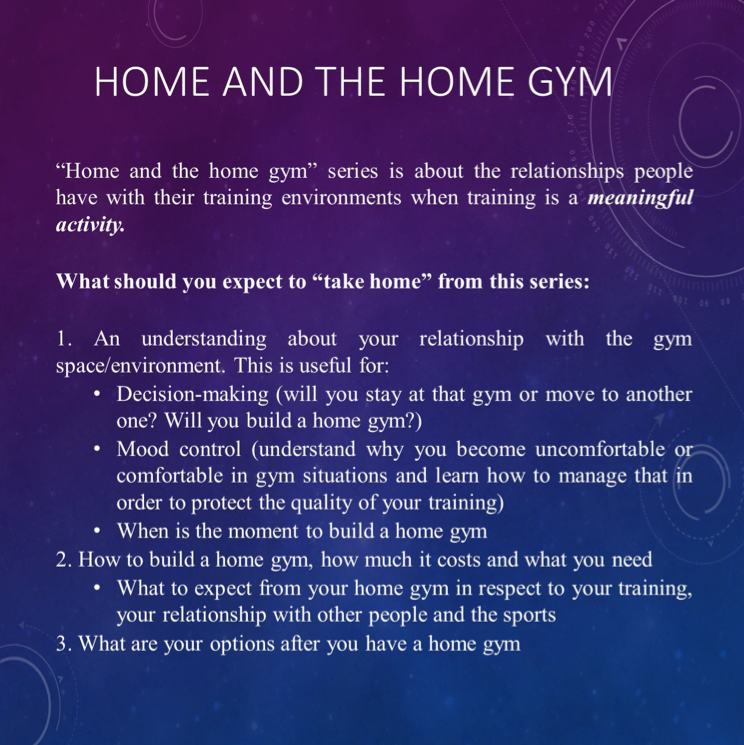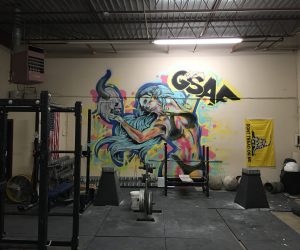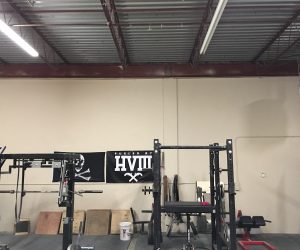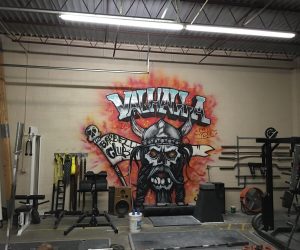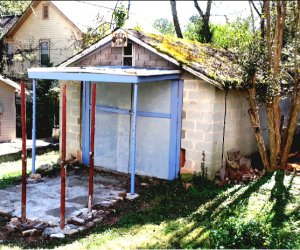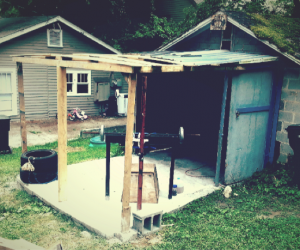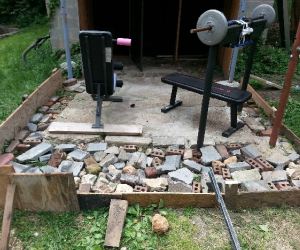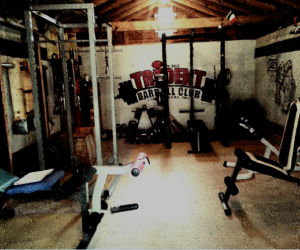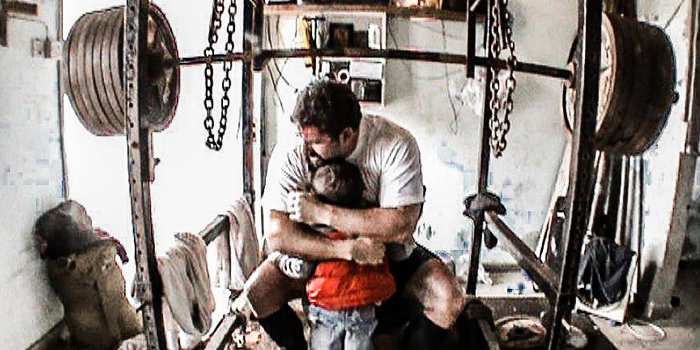
In part one we discussed some of the concepts involved in understanding why we need a “homely” place to lift (“meaningful activity”, “personal space”, “territory”, etc.). In part two you were introduced to some home gyms and their owners. Some of those home gyms started over 15 years ago. Like any home, they change over time. Some change to the point of changing their nature: from an individual’s home gym they may turn into a barbell club or a commercial facility (or a lab!).
Of our original interviewees Chris Duffin’s, Harry Selkow’s, Jack Kottwitz’s and Robert Mantovani’s home gyms evolved into barbell clubs. Of these, Jack’s and Robb’s are closer to the club idea of a collective endeavor, Chris having showed a gradual migration towards the commercial format and Harry at the small commercial facility stage.
To have a better grasp on the several formats and how they may (or may not) evolve into one another, I searched and found a stricto sensu barbell club: the Valhalla Barbell Club, from Wichita, KS. Daniel J. Tennison, one of its members, opened Valhalla’s doors to us and answered an interview.
Small Voluntary Association
Strictly speaking, a barbell club is a “small voluntary association.” This refers to people who organize to operate any enterprise and solve their common problems. Some of the principles that define it apply to widely different things such as babysitting circles, forest people’s local economy, and even cults. All sorts of people share common problems [i].
What is the common problem that barbell clubs organize to solve? Providing a safe, semi-private, personal space for their meaningful activity, which is strength training.
Our case study is a group located in the city of Wichita, Kansas. There was no home-like gym they could adopt as theirs. A home gym could be an alternative, but they decided to skip it, going directly to the barbell club format.
The path from a home gym to the barbell club model involves significant changes in internal dynamics and logistics. Some of them are pretty much impossible to make unless the group moves out of the original owner’s property.
A barbell club has some challenges that home-like gyms and home gyms don’t have. The first and obvious one is the decision-making process. A barbell club proper doesn’t have an owner. Decisions are necessarily collective. Every time choices have to be made by more than one person, decision is time-consuming, potential conflict must be deflected, and accountability becomes tougher. Given that resources are limited and critical, every choice, from where to rent a space, which equipment to acquire, what to do about certain costs, etc., is tough. In voluntary, non-profit organizations, people have day jobs and time is a limiting factor as well; the group can’t just spend all day to decide everything.
PART 1: Home and the Home Gym — The Roots
Managing a self-sufficient barbell club is hard work and requires commitment, flexibility, and less palpable things such as loyalty and altruism. Chances are that there will be personal suffering a couple of times every year. It is in the private space that these issues are processed. Although a barbell club is not a group therapy space, it is, in our space classification, a personal, semi-private, and defensible space — a territory and a family-like environment. Personal achievement, as well as suffering, are at least partly shared. Support, empathy, and privacy are critical. These items are manifested in the club’s everyday life, such as in organizing training schedules. Unlike in any type of commercial gym, everyone knows when a member will compete. Their performance becomes a matter of collective investment. A barbell club is, in all senses, a team.
Commitment is a highly sensitive issue when there are rental and utility contracts, for example. If a large enough number of people give up, the ones left with the burden of paying the bills will be in trouble.
Of all the “homely” and semi-private formats that can host training as a meaningful activity, the barbell club is at the same time the most vulnerable and the one that digs deeper into the significance of that practice for its members.
The financial format is that of a co-op, which is also not that easy to manage. As voluntary associations, co-ops of this type need to be small. The Valhalla has 12 members, Robb’s club has 18 members (but doesn’t pay rent), and it is hard to envision larger barbell clubs for the reasons listed above.
Welcome to Valhalla
It is important to put Valhalla Barbell Club in perspective and the reason it is being featured here. Valhalla is unique and the only “pure” example of a barbell club that I could find. Or, as I put it, a barbell club stricto sensu. I conferenced, informally, with old time lifters. None of them could give me an example of another such club. That doesn’t mean it is better or worse but, in any technical analysis, the closer we get to the “ideal form” of something, the better tooled we are to understand all the phenomena involved.
The full interview with Daniel J. Tennison is here.
Valhalla is located in Wichita, Kansas. Wichita is the largest city in Kansas, with about 390,000 people. There is surprisingly little published research on fitness indicators on Wichita as compared to other important metro areas at the state level. That is consistent with the perception that the whole mid-south is relatively scarce in gym variety, with a higher concentration of commercial, chain gyms.
Valhalla started as a collective initiative:
“I didn't want to lift at home by myself, as I had a pretty solid training group at the time and wanted to continue lifting with them. So the club idea fit better than just a garage gym.” (Tennison)
That seems to be the most relevant factor for the stricto sensu barbell club:
- Premise: Given the inexistence or scarcity of “homely gyms”
- Alternatives: Home gym or barbell club?
- Conclusion: Barbell club
All the other factors are common denominators for the three alternatives. For example:
“A place where we could scream, cuss, spit, bleed, play our music loud, train on our own terms.”
“The main 'idea' of the club was to have a like-minded group of people who had concrete goals for themselves in strength sports with none of the fluffy shit that comes in commercial gyms.”
Compare these to the reasons given by interviewees on part two. They are basically the same. The difference is that given the common problem (the need for a space for the practice of training as a meaningful activity), the solution was sought collectively from start:
“To be completely honest, the whole start up was pretty organic. We just knew what we wanted and designed everything to fit our own mold of what the perfect place would look like, sound like, operate like and went from there.”
They had no blueprint because there is no blueprint. Intuitively, they followed the co-op model:
“We operate as a co-op at this point and dues are collected and put right back into the gym.”
“We took out personal loans and used savings to secure the equipment initially and used some connections and a few donations from family and friends to acquire a little more.”
“We use all member dues to upgrade and sell t-shirts at times to raise a little money here and there.”
This model can only work if there is a very high level of trust and commitment between the members.
“We are a very small, tight, close-knit group, and that was exactly the way we had designed it from the get-go.”
That also means making a choice: will they remain a small voluntary association with collective property and democratic decision-making or will they evolve to a commercial model? This decision guides all the others: growing and accepting new members or not, renting a new place, acquiring new equipment, etc.
“We will not operate as a commercial gym for the foreseeable future.”
Keeping the horizontal family environment intact has a price: slow improvement in infra-structure, being very careful with expenses, and remaining small.
Part 2: Home and the Home Gym: Making Your Home into a Gym
“Being as it's purely member-funded, it does take time. But what we have is ours and belongs to the group.”
“The bills and day-to-day operation costs can stifle adding equipment that we want and that is tough to deal with at times.”
“We make decisions as a group. We have a 'board', if you will, of myself, Mark Olson, and Chad Klaassen. We act as sort of a 'gatekeeping' crew for issues as they arise. If it's something small we will handle it, but if it's something large we ask for input from all members. New members are voted on by the group and that has been the toughest task thus far.”
“I will always strive to keep the familial relationship we all have now and that gets diluted with higher membership.”
The Valhalla group makes not only financial, manual work (“the heavy lifting”) but also intellectual investment. They have complementary skills and, as a team, have reached a pretty rounded-up sports preparation structure:
“It wasn't a goal of ours but many of our members have advanced degrees in science, kinesiology, or exercise science. As far as competitive areas go, we have Highland Games athletes, powerlifters, bodybuilding competitors, and soon an Olympic lifter.”
“We have a group text and plan on gym times that way we can all be together as often as possible.”
What will happen from now on depends on protecting the factors that kept the association successful for almost two years now. They want more physical space and also to provide better support for the athletic achievements of their members. In their case, they have no option other than to be creative:
“We need to expand to a bigger place, first and foremost. I'm working on developing relationships with a supplement store, a butcher shop, and a chiropractic firm to take care of some needs of ours.”
Transitioning from a Home Gym into a Barbell Club
The other interviewees that identified their format as a home gym are either closer to the home gym or to the commercial gym model.
Chris Duffin, like Shawn Lattimer, described different stages of his home gym. From the last home gym, with too many people coming in and out, he moved out of his house to the rental space and into a commercial format. The critical number of people that marked this transition is somewhere between himself and the current over-100 people with a regular membership to his facility. Before that, people made some small contribution to expenses when it was still in his garage.
Harry Selkow is in a hybrid format, with currently 30-50 members but already a business configuration.
Jack and Robb have a hybrid type of training space: It is technically still a home gym—it pays no rent because the space is on their property—but there is some collective arrangement for the use of equipment and training. Jack’s space has been so for a while (seven years) and he describes cycles of participation:
“It varies a lot. We’ve had 16 people in at once and some nights it’s just me and the dogs. Work, school, injury and family have caused members to come and go.”
His home gym “turned into” a barbell club in a less deliberate manner than the stricto sensu Valhalla Barbell Club:
“I had the equipment…why not help others get stronger too? Success breeds success. I wanted to become a good powerlifter, so I decided to build something that would attract the best in the area. Then we’d get stronger together.”
At the end of the day, though, it is still his property, his equipment, and he must have the final say. We can’t just vote to demolish someone else’s wall, for example.
“The gym is part of a place I rent to house my horses. It’s hard to say how much (the rental) is exactly because of that.”
“I just tell people how it is. I have thrown members out in the past. They get one warning, then the gate is locked and they’ll never get back in. I guess I can be an asshole, but I bought everything myself and, in my mind, I’m sharing with others so we can all get stronger. That sharing requires mutual respect. If someone doesn’t have that, or if they are an idiot, then they can find someplace else to train.”
Robb Mantovani’s club is starting the home-club transition now. The present “club” configuration exists for a couple of months only. The home gym pre-existed this for one year. The reason for starting the initiative is the same: people who wanted/needed the same type of training environment, equipment, and perspective.
It's an exciting journey that we will have the chance to follow. These are 18 people committed to being together for the long run, as a team:
“Positive attitude. We have athletes who compete in different sports so flexibility and scheduling is invaluable. Also, respect and the desire to help our members make progress is key.”
Robb Mantovani’s second configuration (club) space:
How to Start a Barbell Club
First and foremost, you need your founding members to have an ironclad commitment to the project. People tend to get excited about an idea just to soon get discouraged by how time consuming or costly it is. What most frequently burns down the early excitement, though, are the demands of “life as it is," including job, school, family, moving, etc. Meeting to discuss medium and long term goals is not a waste of time.
Keep in mind that from the moment the association is created, everything related to it is everybody’s business.
Understand what a co-op is and how it is managed. Here are some useful resources:
Sound financial planning: make sure your project’s budget is thorough. It must contain all one-time (or sporadic) and regular expenses.
Contact other barbell clubs. You might end up deciding to join them (or a “homely” gym) instead of creating your own club. Sometimes learning more about a potential project means shifting to a new project.
If you do decide to go on and create your barbell club, prepare your group to be creative and find innovative solutions to the problems that you will inevitably face.
In the next article, we will examine how home gyms may gain so much symbolic space in a person’s life that they become a professional and occupational choice: a commercial gym is born. Learn how these gyms keep their “homeliness” and offer a unique training experience to their members.
Acknowledgements
Chris Duffin, Harry Selkow, Jack Kottwitz, Robb Mantovani and Elisha Santucci, Daniel Jones Tennison, Chad Klaassen, Mark Olson, Dal Gains, Drew Tennison, Pat Younkin, Max Petersen, Zach Towns, Heather Klaassen, Morgan Colling, Whitney Williams, Jennifer Bates and Brianna Harris.
Header image courtesy of Clint Darden. Read the description on part one, scene four.
References
- Svendsen, Gunnar Lind Haase, and Gert Tinggaard Svendsen. "Homo Voluntarius and the Rural Idyll: Voluntary Work, Trust and Solidarity in Rural and Urban Areas." Journal of Rural and Community Development 11.1 (2016).
- Thiel, Ansgar, and Jochen Mayer. "Characteristics of voluntary sports clubs management: A sociological perspective." European Sport Management Quarterly 9.1 (2009): 81-98.
- Reynolds, Nancy H. "Older volunteer leaders in a rural community (Marion County, Kansas)." (2012).
- Coombs, Gary. "Networks and exchange: The role of social relationships in a small voluntary association." Journal of Anthropological Research (1973): 96-112.
- Wilson, Judy. "Self-help groups as a route to empowerment." Empowerment in community care. Springer US, 1995. 77-95.
- Anila, A. Angel. "A study on Socio-Economic condition of Self Help Group members in Tirunelveli district, Tamilnadu." ZENITH INTERNATIONAL JOURNAL OF BUSINESS ECONOMICS & (2012).
- Lokhande, M. A. "Socio-Economic Impact of Micro Financing through Self-Help Groups in Marathwada Region." The Indian Journal of Commerce vol 61.4 (2008).
[i] The literature about voluntary association in small groups is diverse and does not contemplate issues such as ours. The closest we have to a model of cooperation to solve common problems are micro-financing in rural environments in developing countries, volunteer work in Scandinavia or self-help groups. Each of these models sheds some light on the small voluntary association phenomenon for meaningful activities, but not directly. Surprisingly, the least helpful are the voluntary sport associations, most of which concerned with sanctioning bodies in the sports. See: Svendsen and Svendsen 2016, Thiel and Mayer 2009, Reynolds 2012, Coombs 1973, Wilson 1995, Anila 2012, Lokhande 2008










